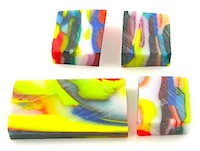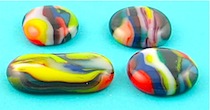Firing Glass Pattern
Bar Slices
Pattern bar slices fused at a high temperature in a glass fusing kiln, above the normal fusing and slumping range, will undergo shape and color changes as the glass heats and begins to flow.
If the temperature is raised to between 1600° F (871° C) and 1700° F (927° C) glass will look like thick syrup and begin to flow. In this state, it can flow off a kiln shelf if it is not contained by a dam of some sort.
Small pieces, carefully monitored, usually do no present this problem unless the shelf is uneven.
Raising the temperature to above 1700° F (927° C) will result in an increase in the glass flow and changes in shape and color.
During this process air bubbles will begin to rise to the surface and will affect color and swirl patterns without actually breaking through the surface layer.
At the highest temperature, some bubbles may rise to the surface requiring attention once the glass has cooled.
In this tutorial the pattern bar slices are 3/8" inch thick, if the slice is too thin it will become distorted around the edges as it shrinks and begins to pull in.
The glass pieces have been cut so that they can be used to create fused glass jewelry.
In the photo below the cross sections show the colors of each piece of fused glass; these shapes and colors will change under the high temperature applied.

When working at high temperatures do not use thinfire paper, as it will break down. Use either 1/8"inch fiber paper or a heavily kiln washed shelf.
Because these are small glass pieces the fusing glass kiln temperature will be raised reasonably quickly to 1650°F (899° C) and held for ten minutes.
Check pieces to see if they have changed shape, the glass will be too hot to see the details of the color changes.
If satisfied turn off glass kiln and allow to cool to room temperature.
As can be seen from the following photo the glass has rounded and the color shift has occured.

The large piece is about 1 1/2" x 3/4" and will make a nice art glass pendant, the round pieces are 1" across.
Always monitor the kiln during high firing to ensure that it does not overheat.
Return From Liquid Stringer To The Glassworks
Return To Home Page



